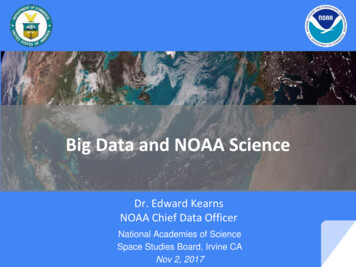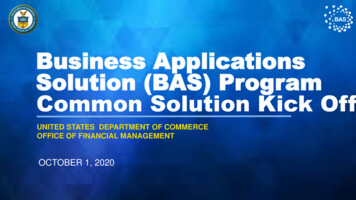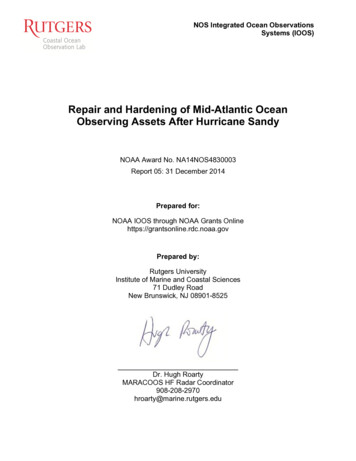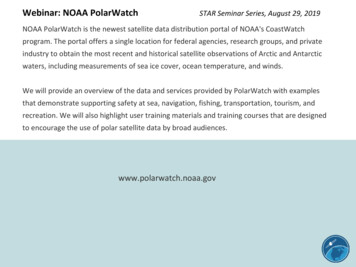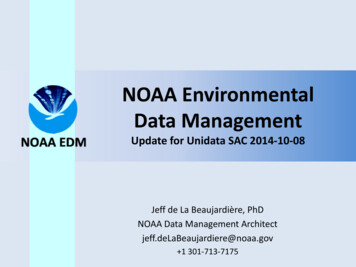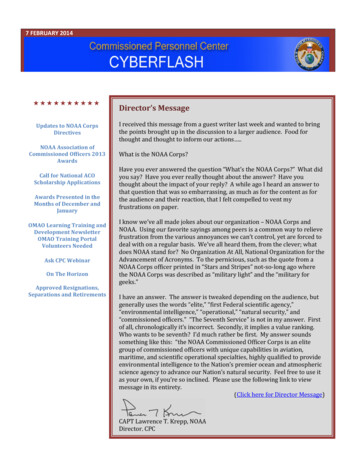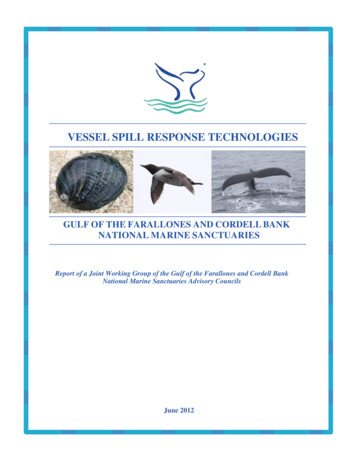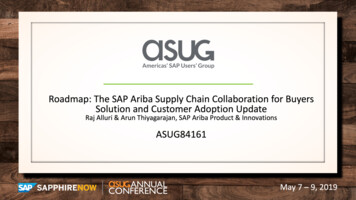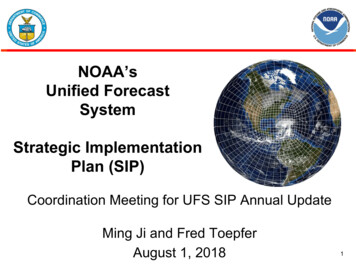
Transcription
NOAA’sUnified ForecastSystemStrategic ImplementationPlan (SIP)Coordination Meeting for UFS SIP Annual UpdateMing Ji and Fred ToepferAugust 1, 20181
Highlights since January FY2019 NGGPS/SIP Kick-off Unified Forecast System Steering CommitteeEstablished CCPP Version 1.0 Released to the Community Hurricane Supplemental Planning Meeting –April 2018 Global FV3 released to the community NCAR-NOAA MOA negotiated – signaturesimmanent2
Unified Forecast SystemNWS Operational Applications3
Unified Forecast System forOperational Earth System Prediction(2018)ESMF/NUOPC/NEMSarchitecture enablesunified global andregional coupledmodeling and DAConsistent withbroader community(CESM) and USNational ESPC44
Unified Forecast SystemGovernancePartners: e.g.NASA GEOS 5,JCSDA, NCAR, NCEP Production SuiteImplementationandOperationsUFS ResearchandDevelopmentGovernance functions at the interface of the NCEP Production Suite, the broader UFS and the broaderresearch and development community. What is being governed is: a community-based, unified,coupled modeling system suitable for application in NCEP’s Production Suite (UFS).5
NOAA – UFS PlanningDocuments Hierarchy6
Approach for Unified ModelingPlanning A concurrent, parallel planning approach– High-level/broad Strategic Plan High-level Strategic Plan accompanying detailedRoadmap document– Short-term (0 to 2-3 years) StrategicImplementation Plan (SIP) combinesimplementation activities with near-term strategicactions Led by NWS/NCEP/EMC with NOAA and externalpartners7
SIP Goals and Objectivesfor Unified Model Common Goal: Single integrated plan that coordinates activities ofNOAA external partners in common goal of building a nationalunified modeling system across temporal and spatial scales– NGGPS: foundation to build upon– Expand to include other STI development programs and EMCdevelopment efforts– Activities include R&D, testing/eval, V&V, R2O, sharedinfrastructure, etc. Approach for SIP development:– Began with existing core R&D partners to organize in functionalarea Working Groups (WGs) responsible for drafting respectivefunctional SIP components– Add/Revise functional Working Groups and Scope as needed.8
SIP Annual Planning Cycle UFS Strategic Implementation Plan - arolling 3-year plan, updated annually– FY18 – 20 (initial cycle) published inNovember 2017– FY19 – 21 to be published October 2018– FY20 – 22 initial kick-off planned for Feb 2019– Planned to be published in Oct 20199
2018 SIP Update Timeline10
SIP Working Groups Communications and Outreach – Common messaging strategy – FV3 transition on global wx/S2S/climate;moving nests for hurricanesConvective Allowing Models (CAMs)– Intermediate steps to CAM ensembles,Warn on Forecast; test/evaluate withcommunitySystem Architecture InfrastructureTesting and Testbeds Verification & Validation (V&V)– V&V of ops forecasts vs. R&Dtesting/evaluate; unified/standard toolsand data formatsEnsembles– Strategy across scales; model uncertainty– Role of testbeds; regression testing; etc. Data Assimilation– DA Science Strategy, FV3 integ. betweenNOAA, NASA; Joint Effort for DA Integ.(JEDI); coupled DA– Standards/doc; CM; code repository; etc. Model Physics– Common Comm. Physics Package (CCPP);stochastic, scale-aware physics– NEMS evolution; community approach Dynamics and Nesting Post-Processing– Comm. PP infrastructure; std formats/tools Component Model sub-groups– Marine models NOS coastal/bay models– Aerosols and Atmospheric Composition– Land Sfc Models (LSMs) hydrology (OWP)UFS-SC/TOB: Decision making, roles/responsibilities, advisory boards, org. alignment11
How STI and OWAQ Use SIP Establish Funding Priorities Make Funding Determinations Use for Hurricane Supplemental Planning– Begin with SIP Modeling Research andDevelopment Activities– Accelerate as appropriate!– Augment as appropriate!12
UFS Next Steps Implement FV3 dynamical core (Global, CAM, HurricaneAnalysis and Forecasting System (HAFS), SupplementalAugment) Accelerate evolution of model physics (Supplementalaugment) Advance overall data assimilation capability (supplementalaugment for JEDI, Dropouts, Science Strategy!) Modernize Infrastructure (NCAR MOA, SupplementalAugment) Foster a community model environment, with GMTB, JCSDA,and community involved governance (FV3 (Global & CAM)and CCPP public releases); incorporate OWAQ fundedactivities into SIP.13
Meeting ObjectivesObjective: To present the status of current SIP Working Groupactivities, and facilitate discussion and coordination amongSIP working groups to finalize updates needed to draft theFY19-FY21 SIP document Groups will present progress and successes, and address issues and dependenciesrequiring resolution Updates on special topics - Hurricane Supplemental, HPC resources Discussion on special topics - Unified Forecast System Governance, CommunityEngagement, Focused sessions in specific areas – Global Model suites, CAM, and DataAssimilation Begin to align with OWAQ funded activities and incorporateinto SIP!
Questions?STI Modeling Program rmation NGGPS:http://www.weather.gov/sti/stimodeling nggpsStrategic Implementation Planhttps://www.weather.gov/sti/stimodeling nggps implementationInformation on Grants:http://www.weather.gov/sti/stigrants15
Back-Up16
NGGPS Goals and Objectives1 Design/Develop/Implement NGGPS global atmosphericprediction model– Non-hydrostatic scalable dynamics Improve data assimilation and physics Position NWS for next generation high performancecomputing Engage community in model/components development Reduce implementation time Increase effectiveness of product distribution– Post-processing, assessments, and displayWorld’s Best Global Forecast Guidance1From NWS Budget Initiative proposal to OMB17
FV3-GFS near-term plans18
FV3-GFS Release Schedule FV3-GFS Release v0– released in May 2017– Access by request (coredevelopers and trusted users)– Limited capability: forecast onlyexperiment on WCOSS, Theia andJet FV3-GFS Release v1– planned for March 2018– Core developers and trusted users to getaccess through Vlab/Git– Public release through github.com– Full capability; including Data Assimilationand Post-Processing– Instructions and documentation at NCEPVlab FV3-GFS community page Access FV3-GFS Project on VLabhttps://vlab.ncep.noaa.gov/web/fv3gfs Code repositories set up on VLab GIT Community Wiki page, Forums andDevelopers Pages on VLab19
FV3 forConvection Allowing ModelsCompletedNear-term Milestones Q3FY17: Initial concept ensembletest case with FV3 nesting on astretched cube (manually run) Q1FY18: More testing with global FV3with a 3 km CONUS nest on a stretchedcube including ensemble display tools Q1FY18: Develop a standalone regionalFV3 capability Q3FY18: Static nests running instandalone regional FV3 Q4FY18: Integration/testing of advancedphysics in nested FV3 Q2FY19: Compare pure FV3-based HREFwith multi-model HREF CAPS was funded by NGGPS to enhance/evaluate FV3at CAM ( 3km) resolution during the HWT SpringExperiment Enhancement included implementation ofThompson microphysics and several PBLschemesEvaluation demonstrated results comparable to WRF20
GMTBCCPP schedule CCPP v1 release (Mar 2018): FY17 GFS Suite in CCPP SCM.Target audience: public release. CCPP Demo capability (Apr 2018): FY17 GFS Suite in CCPP latestFV3-GFS at top of trunk (with modifications to build system, run scriptsetc. to work with CCPP). Target audience: developers and trustedcollaborators. CCPP v2 release (Q3 FY18): FY17 GFS Suite in CCPP FV3 v1.Target audience public. Use FV3-GFS Beta Physics configuration(replace Zhao-Carr with GFDL MP; and other changes to GFS physicsas needed).21
Unified Forecast SystemTechnical Oversight BoardORGANIZATION / POSITIONPRIMARYALTERNATEBoard MembersNWS/STIMing Ji (Co-Chair)OAR/OWAQ/WXJohn Cortinas (Co-Chair)NWS/NCEPBill LapentaNWS/EMCBrian GrossNWS/SWPCBrent GordonOAR/ESRLKevin Kelleher/Robin WebbOAR/GFDLV. RamaswamyOAR/AOMLRobert AtlasOAR/ARLAriel SteinOAR/GLERLDeborah LeeOAR/NSSLStephen KochOAR/CPOWayne HigginsNOS/CSDLRichard Edwing?NASASteven Pawson/Tsengdar LeeNCAR/RALScott Swerdlin/Louisa NanceNCAR/MMMChris DavisNCAR/CGDBill LargeOWPTom GrazianoNAVY/NRL StennisRuth PrellerHendrik TolmanVijay TallapragadaWhit Anderson22
-High-level/broad Strategic Plan High-level Strategic Plan accompanying detailed Roadmap document -Short-term (0 to 2-3 years) Strategic Implementation Plan (SIP) combines implementation activities with near-term strategic actions Led by NWS/NCEP/EMC with NOAA and external partners. 8
